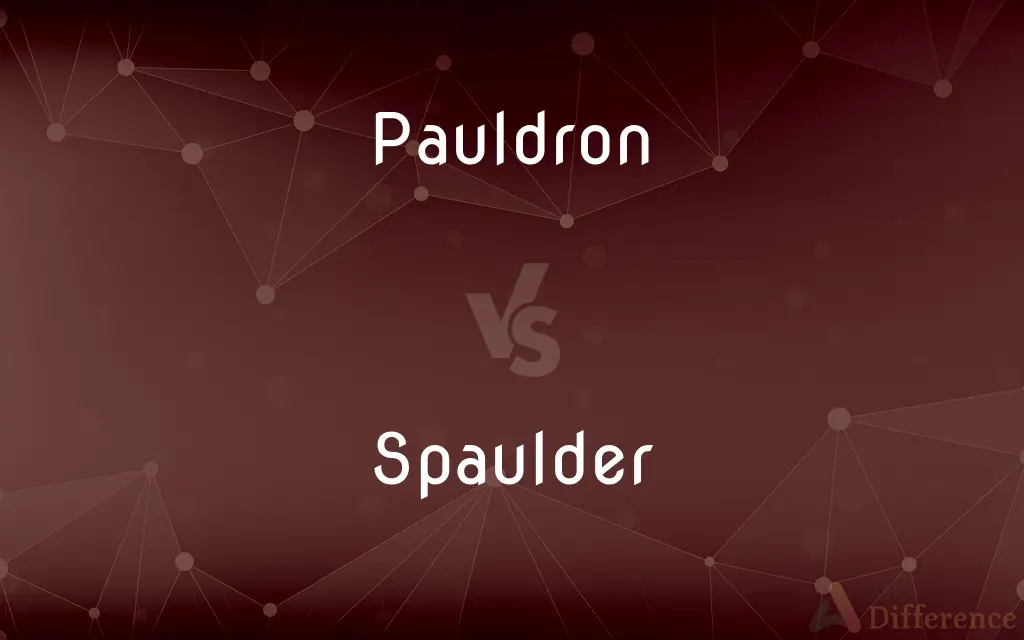Pauldron vs. Spaulder — What's the Difference?
By Maham Liaqat & Urooj Arif — Updated on April 29, 2024
Pauldrons are large, often ornate shoulder pieces in armor that cover the shoulder area with multiple plates; spaulders are smaller, simpler, and cover the shoulder with a single plate.

Difference Between Pauldron and Spaulder
Table of Contents
ADVERTISEMENT
Key Differences
Pauldrons are a type of armor that covers the shoulders, extending sometimes from the neck to the upper arm, providing extensive protection. They typically consist of multiple overlapping plates that allow for greater mobility while still safeguarding the wearer. On the other hand, spaulders are also designed to protect the shoulder but are generally smaller and consist of a single, sometimes slightly articulated plate, making them lighter and less cumbersome than pauldrons.
In historical armor sets, pauldrons were often used in full plate armor configurations, popular among knights and heavy infantry from the medieval period through the Renaissance. Whereas, spaulders were more commonly associated with lighter armor setups, useful for skirmishers or soldiers requiring greater mobility on the battlefield.
Pauldrons often feature intricate designs and embellishments, reflecting status and wealth, especially in ceremonial or parade armor. In contrast, spaulders are typically more functional with less decoration, prioritizing ease of movement and speed over ornate design.
Due to their larger size and coverage, pauldrons provide better protection against downward strikes from weapons like swords or axes. Conversely, spaulders, while offering essential protection, leave more of the arm and upper body exposed to such attacks, trading some safety for flexibility.
While both armor types are less commonly used in modern times except for historical reenactment or in entertainment media like video games and movies, pauldrons have seen a more significant cultural impact, often being featured prominently in fantasy and science fiction genres to convey power and protection.
ADVERTISEMENT
Comparison Chart
Coverage
Extensive, multiple plates
Limited, usually a single plate
Mobility
Allows good mobility with articulated plates
Higher mobility due to smaller size
Usage
Full plate armor, knights
Lighter armor, skirmishers
Design
Often ornate, symbolizing status
More functional, less decoration
Protection Level
Higher, covers more of the shoulder and arm
Less, exposes more of the arm and shoulder
Compare with Definitions
Pauldron
Often used in heavy armor to protect against blows to the shoulder.
His pauldron deflected the downward strike of the axe.
Spaulder
Designed for lighter armor needs and greater mobility.
His spaulder allowed quick movements, crucial for skirmishes.
Pauldron
Covers from the neck to the upper arm for extensive protection.
The pauldron extended down to his bicep, offering substantial protection.
Spaulder
A single plate of armor covering the shoulder.
The archer wore a spaulder to retain arm mobility.
Pauldron
Typically part of a full armor set.
The museum's display included a 16th-century suit of armor with a large pauldron.
Spaulder
Less ornate, focusing on functionality.
The soldier's spaulder was plain but effective.
Pauldron
A piece of armor covering the shoulder with multiple articulated plates.
The knight's pauldron was embellished with the crest of his house.
Spaulder
Part of lighter, more flexible armor configurations.
For reconnaissance missions, he preferred armor with just a spaulder.
Pauldron
Can be highly decorative, used in ceremonial gear.
The ceremonial armor's pauldron was adorned with gold inlays.
Spaulder
Provides essential protection without the bulk of larger armor pieces.
The spaulder protected her shoulder without weighing her down.
Pauldron
A pauldron (sometimes spelled pouldron or powldron) is a component of plate armor that evolved from spaulders in the 15th century. As with spaulders, pauldrons cover the shoulder area.
Spaulder
Spaulders are pieces of armour in a harness of plate armour. Typically, they are a single plate of steel or iron covering the shoulder with bands (lames) joined by straps of leather or rivets.
Pauldron
A component of plate armor that protects the shoulder, generally covering more than a spaulder, also protecting the armpit and overlapping with other armor over the upper chest and back.
Spaulder
A piece of plate armour that protects one's shoulder, generally covering less than the pauldron which developed later.
Pauldron
A piece of armor covering the shoulder at the junction of the body piece and arm piece.
Common Curiosities
What is a spaulder?
A spaulder is a lighter, simpler form of shoulder armor, typically consisting of a single plate.
Why might a knight choose a pauldron over a spaulder?
A knight might choose a pauldron for its superior protection and status-enhancing designs, especially in heavy combat scenarios.
What is a pauldron?
A pauldron is a component of medieval and Renaissance armor, covering the shoulder area with multiple plates for extensive protection.
Can spaulders be used in heavy armor configurations?
While less common, spaulders can be part of lighter heavy armor configurations, especially where mobility and speed are required.
Are pauldrons more decorative than spaulders?
Yes, pauldrons are often more decorative and elaborate, reflecting the wearer's status and role, unlike the more functional spaulders.
What historical periods featured the use of pauldrons and spaulders?
Both pauldrons and spaulders were prominent from the medieval period through the Renaissance in various forms of military armor.
In what contexts are spaulders still used today?
Spaulders are used in historical reenactments, LARP (Live Action Role Playing), and in theatrical or film representations of historical or fantasy settings.
How do pauldrons differ from spaulders in terms of protection?
Pauldrons offer more extensive protection by covering more of the shoulder and upper arm, whereas spaulders cover less area to allow greater mobility.
How do pauldrons and spaulders affect an armor wearer's mobility?
Pauldrons, despite their size, are designed to allow good mobility with articulated plates, while spaulders, being smaller and lighter, offer even greater mobility.
What materials are pauldrons and spaulders made from?
Historically, both were primarily made from metals like steel or iron, though modern replicas may use lighter or synthetic materials.
What are the aesthetic implications of choosing one type of shoulder armor over the other?
Choosing pauldrons can suggest a more formidable, ornate appearance suitable for high-ranking figures or ceremonial uses, while spaulders suggest practicality and agility, ideal for active or less formal roles.
How does the weight of pauldrons compare to spaulders?
Pauldrons are generally heavier due to their larger size and multiple plates, whereas spaulders are lighter, aiding in agility.
What role does each type of armor play in modern cultural depictions?
In modern culture, pauldrons often appear in fantasy and sci-fi genres to convey power and protection, while spaulders are seen in more historically accurate or realistic portrayals.
Is there a functional benefit to the design variations between pauldrons and spaulders?
Yes, the design variations cater to different needs: pauldrons provide better protection and ceremonial aesthetics, while spaulders offer greater flexibility and speed.
Can either armor piece be adjusted to fit different body sizes?
Yes, both pauldrons and spaulders can be adjusted or made to fit different body sizes, though pauldrons may require more extensive customization due to their complexity.
Share Your Discovery

Previous Comparison
Trait vs. Temperament
Next Comparison
Ram vs. IbexAuthor Spotlight
Written by
Maham LiaqatCo-written by
Urooj ArifUrooj is a skilled content writer at Ask Difference, known for her exceptional ability to simplify complex topics into engaging and informative content. With a passion for research and a flair for clear, concise writing, she consistently delivers articles that resonate with our diverse audience.














































